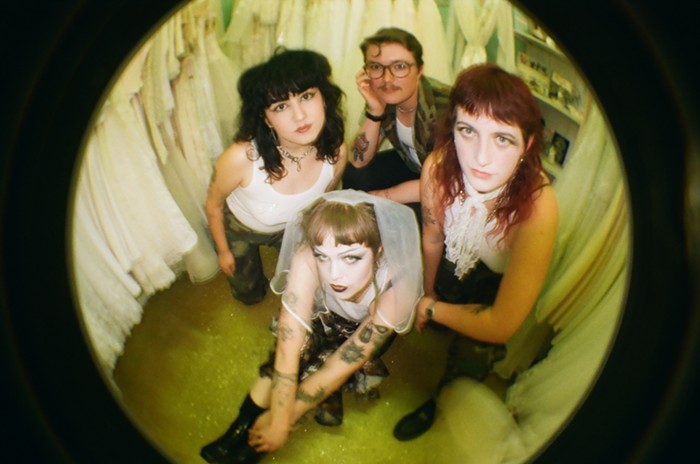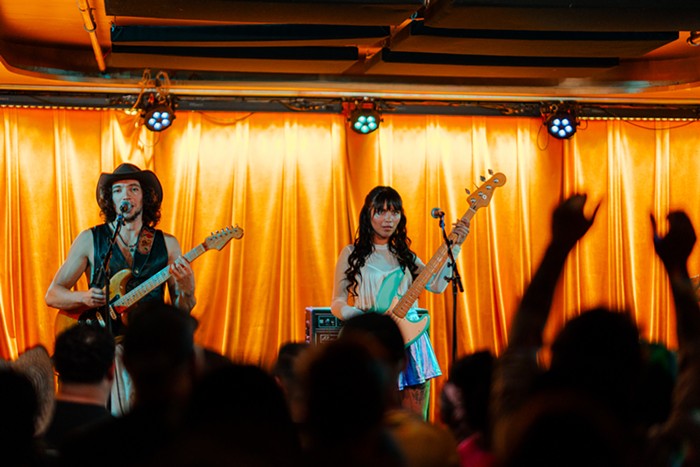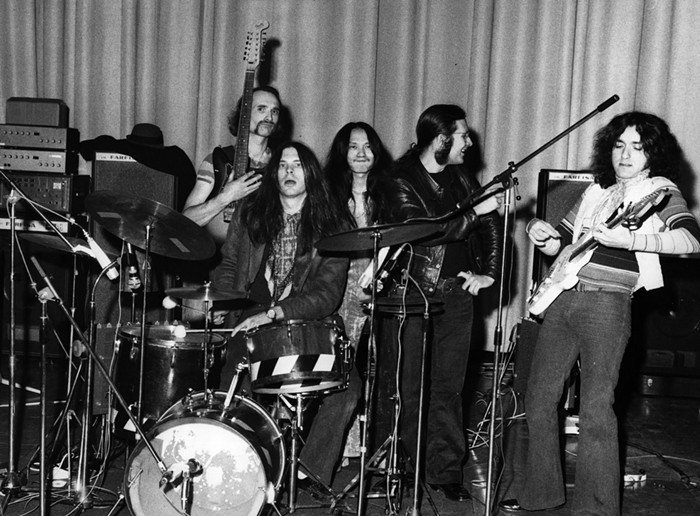Dead Ship Sailing are a hazy rock two-piece that make highly mobile sounds. Their scaled-down, guitar-based drone 'n' drive pulls you in on a line. For the recording of their debut, self-titled album, the Seattle-based husband and wife duo of Graig Markel and Zera Marvel gave themselves a set of parameters to work within. Each song was written, recorded, and mixed in a single evening in their own Recovery Room Studio. With guitars, vintage drum machines, and effects pedals (that Markel hand-wires himself), they made one song per week for 10 weeks. This "first-thought, best-thought" methodology generated rough-hewn, Warhol Factory pop motifs. Think the Kills/Raveonettes with streaks of the Soft Moon/Moon Duo—the songs are bleak and seducing with big rhythmic fuzz. Markel's distorted and taut opioid riffs travel well with Marvel's ghost-shrouded vocals. By minimizing within a one-night window, Marvel and Markel swell and expand. We spoke.
What made you all want to record your album within set guidelines?
G: As a producer, I spend a lot of time convincing bands to stop fiddling, redoing, editing, and mixing. Usually the best performance is the first or second take. The benefit of the time-constraint rule is that you get what you get—results can be edgier and gritty. The downfalls are that you get what you get, and sometimes it sucks [laughs].
Z: We wanted to keep things simple. Putting a time limit on ourselves prevented us from overdoing things, and that's what gives the songs a raw, frantic feel and forced us to embrace imperfection.
Did you really not make any adjustments after the one night?
Z: I didn't. Graig may have rerecorded all his parts when I wasn't home.
G: After we chose the songs that made it on the record, I gave myself one week to master and make minor mix adjustments. No tracks were allowed to be altered.
What's the story behind your song "Steady and Straight"?
Z: I had only about 20 to 30 minutes to come up with the words for that song, so there's no tantalizing story. You can make one up if you want. The drum machine is a Korg KPR-77 with some damage in the chain. Its name is Peter Thumper.
I want a tantalizing story. I see a futuristic, three-mile-long racetrack, and two racers who hate each other. It's night and raining. They're going like 300 miles per hour. One of them races in a machine that's decrepit and run-down—she needs to win to feed her family. The other racer is a dick, he's all new and sponsored, and he cheats. He puts drugs in her water bottle before the race starts, but she wins anyway. During the final laps, she hallucinates that Helen Keller is in the racing pod with her. Keller guides her to victory, steering her through an impossible obstacle course. Maybe afterward they go for cold beers—Keller enjoys an ice-cold Budweiser after a hard race.
Z: Wow, that is tantalizing. I'll start telling people [laughs]. She calls her race machine Peter Thumper. They're flying, right?
Graig, you make your own effects pedals? Your sounds are so sweet and gnarly.
G: I do. I make the pedals we use for fuzz, distortion, delay, and reverb. Everything is point-to-point hand-wired. I also made the tube preamp that we use for Zera's vocals. Recovery Effects is the name of our effects line. There are eight pedals now.
Z: While some men look at porn, Graig looks at schematics.
Explain point-to-point hand-wiring. Why do I want that?
G: Most pedals, even handmade boutique pedals, use a printed circuit board that uses tiny traces of metal printed on the board to get the signal from one point to another. The ones I make don't use printed circuit boards. Instead, each component is connected together by their leads and thick solder joints. The thicker connection points provide a bolder, richer tone. When you spend the extra money for a hand-wired amp and thick quality cables, you should try to keep the same quality in your effects chain.
When y'all play live, what's the setup?
Z: White lights and smoke machines.
G: Girl, dude, drum machine. Girl and dude play guitars. Drum machine does not. Girl sings. Sometimes dude sings.
You two built your own studio, Recovery Room, by renovating a big shed behind your house. Please talk about powering through walls like a bulldozer.
Z: There were no walls to knock down, just walls to build. I did a lot of mudding and sanding of drywall—I never want to do that again. I find most home-renovation projects end with me saying, "I never want to do that again." When we bought our house, it was really neglected and needed work. Most people would probably fix up the house first, but we got straight to work turning the outbuilding into a studio. Priorities!
G: I almost shot a nail through my friend Bailey's hand. Missed him by a hair [laughs]. A few months later, I almost cut his finger.
Y'all are married. How does that help and/or hinder?
Z: When we're playing music, I don't think about the fact that we're married. You have to lose yourself a little, and that's harder to do when you've known someone for a while, whether you're married or not.
What's this about you having an epileptic cat?
Z: We have an epileptic cat. Her name is Pearl. Does anyone else out there have an epileptic cat?
Are there any other husband/wife bands out there that you look up to, or pity?
G: Billy Davis Jr. and Marilyn McCoo have been making it work for a while. The Captain and Tennille were tight. Peaches and Herb. Bobby and Whitney never really jammed, but they had a great TV show.
Z: I would have said Sonic Youth's Thurston Moore and Kim Gordon, but we all know how that ended.
What's an example of some music where a band gave themselves a set of rules to follow during the recording that would force them to be creative in a different way?
G: The entire Stax catalog was built with constraints. Everything from using the same studio and house band, to rules about tempo and shying away from minor chords helped shape the sound of that label. Bruce Springsteen moving away from a big production album to record Nebraska on a four-track at his house yielded arguably the best album of his career. EMI holding out on giving the Beatles access to a new-fangled eight-track in hopes of keeping the band more efficient in the studio no doubt shaped their recordings.
Who have you been working with lately in Recovery Room?
G: Recent highlights are Brent Amaker and the Rodeo, Grizzled Mighty, Motopony, Sick Secrets, Terri Tarantula, the Walkabouts, and Barton Carroll. Getting ready for the new Fox and the Law album.
Z: I like when the Rodeo comes over. Brent always brings good wine and snacks.
Is owning your own studio like owning a roller coaster? I mean, when you go to an amusement park, you get to go on the roller coaster like, twice, and it fucking rules, but if you owned the roller coaster and could go on it whenever, would it be as special?
G: I wish I could go in my studio whenever, but there's usually a band in there trying to be convinced that their previous take was better than the one they just did [laughs].
Z: When you have the ability to spend endless hours working on something, it's even more important to challenge yourself and do something other than what you are used to. Our goal was to break any old habits and keep it fun. ![]()


















